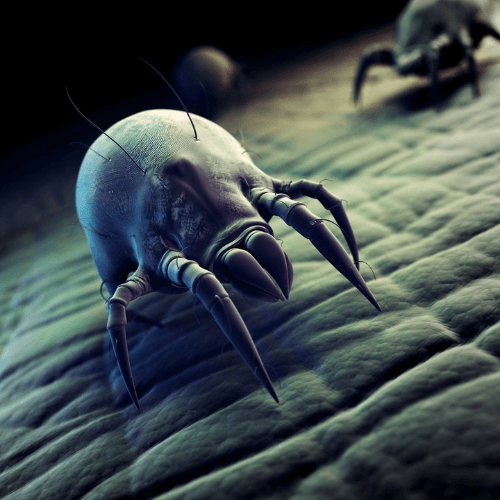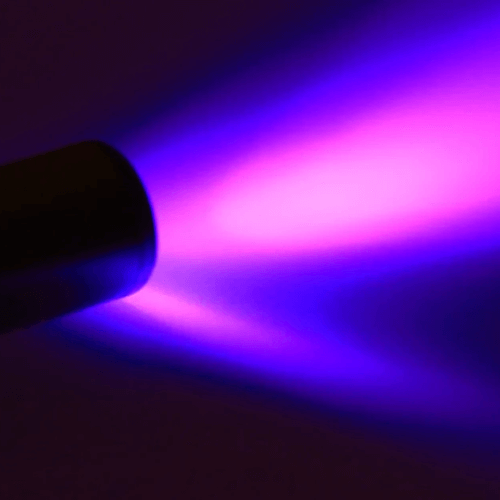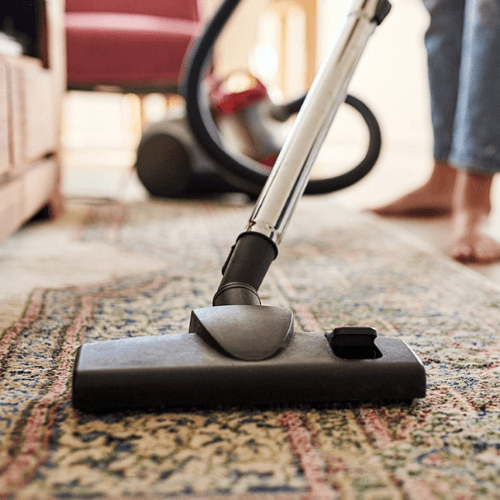Dust mites are an all too common problem for many households. They can cause irritation and allergies, but what if there was a way to get rid of them? Could UV light be the answer?
This article will explore this question and look at whether UV light can effectively kill dust mites.
- Is there a natural way to get rid of dust mites?
- Is UV light effective solution?
- Do ultraviolet rays have any side effects?
In various industries, UV light is used to disinfect surfaces and kill bacteria. It stands to reason, therefore, that it could also be used to kill dust mites.
In this article, we’ll examine the evidence for using UV light as an effective method of killing these pesky bugs.
1. What Are Dust Mites?

Diligent dust mites dot the domains of dwellings. Devoid of visible visibility, these diminutive creatures can be found everywhere in the home, often causing mischief and mayhem.
Dust mites are microscopic arachnids that feed on miniscule particles of skin from humans and animals. They require a warm and humid environment to survive, making them a common presence in households across the world.
Not only do dust mites thrive in many environments, but they can also live for several months without food or water.
This makes them highly adaptive and difficult to eradicate as they will simply relocate if disturbed or threatened.
As such, understanding how dust mites spread is essential for controlling their population in your home.
2. How Do Dust Mites Spread?
Dust mites seem to be everywhere, lurking in carpets and bedding like a hidden horror movie monster. They’re practically invisible, yet their impact on human health can be profound. So how do these tiny creatures spread?
Most dust mite activity occurs in the bedroom. Their favorite habitats are mattresses, pillows, blankets and carpets.
They feed on dead skin cells that humans shed every day. To survive, they need moisture, which is why they’re often found in humid places like bathrooms and kitchens as well.
When disturbed or bumped into, dust mites can leave particles of feces and other allergens airborne in the home.
These particles can then be inhaled or ingested by humans, triggering an allergic reaction that ranges from mild to severe.
The best way to prevent dust mite infestation is regular cleaning and vacuuming with a HEPA filter vacuum cleaner to reduce their population in the home environment.
To understand the impact of dust mites on human health better, it’s important to know what health effects they cause.
3. What Are The Health Effects Of Dust Mites?
It’s ironic that something so small can have such a powerful effect on our health. Dust mites, those tiny pests lurking in our mattresses and carpets, can have far-reaching consequences. But what are they?
Dust mites are microscopic arthropods that feed on the dead skin cells of humans and animals. They’re everywhere: in carpets, mattresses, bedding, and furniture. And if you’re allergic to them, their effects can be uncomfortable or even life-threatening.
Dust mites cause a variety of symptoms in people who suffer from allergies or asthma.
These include sneezing, coughing, wheezing, itchy eyes and nose, runny nose, headaches and fatigue.
But the most serious health effect is anaphylaxis – a potentially life-threatening reaction that requires immediate medical attention.
The only way to protect ourselves from dust mites is to limit their spread through regular cleaning and vacuuming. But when these measures fail, we must look elsewhere for solutions – like ultraviolet light…
4. What Is Ultraviolet Light?

Ultraviolet light is like a brilliant sunbeam beaming down from the heavens. It’s mysterious and powerful, yet often overlooked.
It can be found in nature, but it’s also produced artificially with special lamps used to disinfect and cleanse surfaces.
Just what is this enigmatic force? To start, ultraviolet (UV) light is part of the electromagnetic spectrum that extends beyond visible light—the rainbow of colors we can see with our eyes.
UV light exists as three distinct types: UVA, UVB, and UVC. UVA rays are longer-wavelength rays that cause tanning and cause less damage to our skin compared to other UV rays.
On the other end of the spectrum are the much shorter wavelength UVC rays which mostly get absorbed by Earth’s atmosphere before reaching us.
In between these two extremes are UVB rays which have a medium-length wavelength and reach us more readily than UVC rays, making them potentially hazardous for unprotected exposure.
These rays are especially strong during midday hours, when they’re at their peak intensity levels.
So it’s important to take precautions against them when spending extended time outdoors during those times.
UV light has many uses, most notably its ability to destroy bacteria and microorganisms through its germicidal properties.
This makes it invaluable for sterilizing medical equipment and purifying water supplies, among other things. But its effectiveness in killing organisms also means it could prove useful in eliminating dust mites too—a topic we’ll explore further in the next section.
5. How Does Ultraviolet Light Impact Dust Mites?
It’s no secret that dust mites can be a major nuisance, but did you know that the average person sheds up to 1.5 grams of skin a week? This is enough for thousands of dust mites to feed on, making them difficult to eradicate from carpets and furniture. But what about ultraviolet light? How does it impact these pesky little critters?
Ultraviolet light, or UV light for short, is a type of electromagnetic radiation with a wavelength shorter than visible light.
It has germicidal properties and has been used to kill microorganisms since the 1920s. When exposed to UV light, dust mites die within minutes due to DNA damage caused by the radiation.
The effectiveness of UV light in killing dust mites depends on several factors such as intensity, duration of exposure, and distance from the source.
Generally speaking, higher intensities will kill more dust mites faster than lower ones.
TIP: Place your furniture near windows whenever possible so that natural sunlight can help reduce the number of dust mites in your home!
6. How To Use Ultraviolet Light
Ultraviolet light has long been used tokill bacteria and other microorganisms. It can also be used to kill dust mites. To use it, the affected area must first be exposed to UV light.
This could mean using a UV lamp or placing the space outside in direct sunlight for a period of time.
It’s important to note that UV light won’t penetrate all fabrics, so if the fabric is too thick, it won’t work.
Another thing to consider when using UV light is that it can be dangerous for humans – overexposure can cause skin damage and even cancer.
Therefore, it’s best to use caution when exposing yourself or others to this type of light.
UV light is an effective way of killing dust mites, but it’s not always practical or safe. To move on now, we’ll look at how effective ultraviolet light is in killing dust mites.
7. Effectiveness Of Ultraviolet Light In Killing Dust Mites
Light can be likened to a magical wand that can make all the darkness in a person’s life vanish. It is no different when it comes to killing dust mites.
Ultraviolet (UV) light is one of the most effective ways of eradicating these pesky creatures from our homes and workspaces.
The question now is how effective UV light really is against dust mites?
The answer is, very effective. UV light has been proven to be an effective method for killing dust mites, their eggs, and other contaminants.
Studies have shown that exposing dust mites to UV radiation for a period of time will kill up to 99% of them. Furthermore, the process doesn’t require any chemical or pesticide use and won’t damage furniture or fabrics either.
This makes UV light an attractive option for people looking for a safe and efficient way to rid their space of dust mites without having to resort to harsh chemicals or pesticides.
It’s also relatively inexpensive and can be used on virtually any surface in the home, making it a great choice for those looking for an economical way of getting rid of these pests.
8. Pros And Cons Of Using Ultraviolet Light To Kill Dust Mites
Ultraviolet light has been used for many years to kill dust mites, but it can also come with a few drawbacks. It’s time to weigh the pros and cons of this method – let’s take a closer look.
Like many things in life, ultraviolet light has two sides: the good and the bad.
On the one hand, UV light is effective in killing dust mites, as it destroys their exoskeletons and leaves them unable to reproduce.
This makes it a great choice for controlling dust mite populations in homes, offices and other areas. Plus, UV lights are easy to use and don’t require any special chemicals or treatments.
On the flip side, there are some risks associated with using UV light to kill dust mites. For one thing, it’s not always easy to reach all of the areas where dust mites may be hiding.
That means that even if you use UV lights, some of the mites may still remain alive and active.
In addition, prolonged exposure to UV radiation can be damaging to humans, so proper safety precautions must be taken when using these lights.
So while ultraviolet light offers an effective way of killing dust mites, it’s important to consider both its benefits and potential risks before making a decision about which method is best for your particular situation.
9. Alternatives

Ultraviolet light may be a tempting solution for dust mite infestations, but it is far from the only one. Nowadays, there are many alternatives that can help to rid your home of these pesky pests. Let’s dive deeper and explore them in detail.
For starters, vacuuming frequently is the easiest way to reduce dust mites. Vacuums with HEPA filters are especially effective since they trap even the smallest particles in their bins.
Additionally, steam cleaning can also kill dust mites by exposing them to high temperatures.
An old-fashioned but still effective approach is laundering bedding in hot water on a regular basis.
All of these methods have been proven to reduce dust mite populations significantly, so give them a try!
Finally, some natural remedies may be able to help out as well.
For example, tea tree oil has been used for years to repel insects and other bugs; you can apply it directly onto fabrics or diffuse it in the air.
Similarly, lavender oil is said to have antifungal and antimicrobial properties; this makes it an ideal option for fighting off dust mites too!
So while ultraviolet light may make sense at first glance, there are plenty of ways to take care of your dust mite problem without having to resort to that extreme measure.
Before moving forward with any decision though, it’s important to consider all safety considerations associated with using ultraviolet light – let’s take a closer look at those now.
10. Safety Considerations
Exploring the efficacy of ultraviolet light to eradicate dust mites can lead to an effective resolution.
However, safety considerations must be taken into account when implementing this solution.
From the potential for eye and skin damage to the impact on other living organisms, it’s essential to understand what UV light entails before using it.
When using ultraviolet light as a means of killing dust mites, precaution should be paramount. Prolonged exposure to the UV rays can cause severe harm to human eyes and skin, so protective eyewear and clothing is a must.
Moreover, if not managed properly, UV light can also have detrimental effects on other living organisms such as plants, insects, and pets.
Therefore, proper ventilation while using these lights is necessary in order to avoid unwanted consequences.
UV lamps are an effective way of eliminating dust mites but they must be employed judiciously and with careful consideration for environmental factors.
Before making use of this technology, it is important to do research in order to understand its advantages and limitations in order to make sure that no unintended damage or harm occurs due its usage.
By understanding these implications beforehand and taking adequate safety measures while utilizing it, one can successfully employ ultraviolet light as a way of eliminating dust mites without endangering oneself or nearby living organisms.
Frequently Asked Questions
How Long Does Ultraviolet Light Take To Kill Dust Mites?
It’s a coincidence that you are asking about ultraviolet light and dust mites. We’ve all encountered dust mites at some point, and if you haven’t, it’s only a matter of time. So, how long does UV light take to kill them?
UV light is effective in killing dust mites because it disrupts their DNA. It can take anywhere from 30 minutes to two hours for UV light to completely eradicate dust mites. But that depends on the strength of the UV light, so the exact time may vary.
The best way to use UV light to get rid of dust mites is to place items like mattresses or rugs in direct sunlight for an extended period of time. This method works well because the sun is naturally full of UV rays which will penetrate throughout the item, killing off any dust mites that are present.
Using UV light as a form of pest control has become increasingly popular recently as an alternative to chemical treatments. Not only is it more cost-effective, but it also offers peace of mind knowing that no chemicals are being used around your home or family.
Are There Any Side Effects From Exposure To Ultraviolet Light?
The potential effects of exposure to ultraviolet light are often overlooked, with many believing that it is a harmless source of sanitization.
But while UV light can be an effective weapon against dust mites, there are some serious side effects that must be taken into consideration.
The risks associated with exposure to UV light are numerous; from skin damage to eye damage, and even cancer in some cases.
It is important to understand the full implications of using UV light for cleaning purposes before engaging in such activities. Here’s what you need to know:
a. Skin Damage: Prolonged exposure to UV rays can cause sunburns and premature aging of the skin.
b. Eye Damage: Exposure can also lead to photokeratitis, which is a painful condition causing redness and swelling of the eyes.
c. Cancer Risk: Studies have indicated that long-term exposure may increase the risk of developing certain types of cancer.
d. Other Risks: There is also evidence suggesting that UV radiation can weaken the immune system and contribute to cardiovascular disease.
No one should underestimate the potential dangers posed by UV light; it is important that individuals take all appropriate precautions when using this type of sanitization method.
From wearing protective clothing and eyewear, to avoiding prolonged exposure and limiting use around children and pregnant women – these steps should all be taken seriously when considering using UV light as a means of disinfection or pest control.
To sum up, understanding the implications and taking all necessary safety precautions is essential when considering using ultraviolet light for any purpose.
Can Ultraviolet Light Kill Other Allergens In Addition To Dust Mites?
Ultraviolet light is a safe and effective way to kill dust mites in homes and other environments. But can UV light also be used to eliminate other allergens?
The answer is yes. UV light has been shown to effectively reduce the presence of pollen, mold, pet dander, and bacteria in indoor spaces. Here are some key facts:
a. UV light kills allergens by neutralizing the proteins that make them dangerous
b. It works quickly and without the use of harsh chemicals or sprays
c. It can be used as part of a regular cleaning regimen for improved air quality.
UV lights are a great solution for those looking for an eco-friendly way to keep their homes free from allergens. They provide long-term results that won’t put people or pets at risk.
And they’re easy to operate so users don’t have to worry about any complicated setup processes. All in all, it’s an effective tool for reducing allergens in indoor environments.
Conclusion
Ultraviolet light is an effective way to kill dust mites, but it’s important to understand the risks and benefits before using it.
The sun is a great example of UV radiation, and its power can be harnessed for good in our homes. We can use this energy to help us fight off dust mites and other allergens.
However, it’s important to know that overexposure to this energy can have negative side effects on both humans and pets.
Ultimately, it’s up to each person or family to decide if UV light is right for them. It can be a great tool for killing dust mites, but there are potential risks involved.
Consider all angles carefully and make sure you’re taking proper safety precautions when using ultraviolet light in your home.





